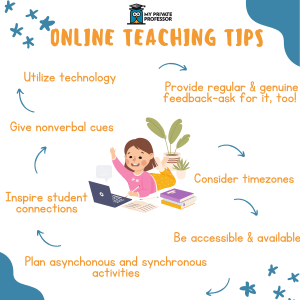Online teaching: (kind of) the new normal
Online teaching is weird. Let’s face it—for many of us, sitting in front of a screen all day, everyday, is not ideal.
Whether you’re becoming an online tutor, teaching a remote seminar, or doing online test-prep, online teaching is something that’s becoming more and more the new normal.
Since remote work and online learning can be a difficult adjustment for both students and teachers, there’s no harm in brushing up on the basics (which aren’t actually so basic when you’re used to in-person teaching).
Utilize online tools
One of the great things about this time is that we’ve made so many technological advancements to the point where online teaching is possible, and can be entirely successful.
Since you’re not going to be physically handing out assignments, you’ll need an online learning management system. Luckily there are several to choose from, including Canvas and Blackboard. With this type of tool, you’ll be able to more easily divide up all the material, whether it be by unit or particular lessons. You can also create discussion boards and store all your multimedia materials so students can have access at all times.
Many students (myself included!) have found that recorded lectures are a great tool for studying and relearning lessons. Recordings are particularly useful for those who find it challenging to focus on online lessons.
If you’re not one to spend hours typing up responses, you can use dictation tools that convert your voice to text. These are available on programs such as Word 365 and Google Docs. Not only will this give your hands a break, but you’ll save time.
It’s also important to get comfortable with common technological issues and understand how to get tech support if you/your student can fix any given issue.
Ask for & provide feedback
If you’re feeling overwhelmed with online teaching, seek refuge in your student(s). Online teaching may be new for everyone, so asking for feedback is a great way to develop better lessons, strategies, and teaching methods.
In addition to receiving feedback, remember that your students may feel overwhelmed and lost, and will probably greatly appreciate your feedback on assignments and performance.
You can even utilize technology to do this—you can use a screen recording tool while recording your voice so that you can talk your student through any document or assignment. Plus, many students find listening to feedback more helpful than just reading a bunch of comments.
Go beyond verbal communication
One of the most challenging parts of online teaching and learning is the lack of nonverbal cues. In order to most effectively communicate, it’s important to utilize nonverbal cues—this can be through facial expressions, hand gestures, or movements.
A 2017 study demonstrated that the more regularly teachers implemented non-verbal cues, the more the students progressed, academically.
Try to put yourself in your students’ shoes. For the student, it can be difficult to communicate when you have no real understanding of their teacher’s emotions.
Encourage student connections
It’s completely understandable for students to feel frustrated, alone, or anxious when trying to navigate online life. In reality, online life isn’t something most of us have ever experienced.
Everyone is trying to figure out what works best for them and how to manage their new schedules. And it can be difficult to feel like you’re creating genuine connections with others when you’re constantly communicating through a screen.
This is why forming connections with other students can be extremely beneficial. Forming online connections allows students to bond about online learning and ask each other questions or form study groups.
You can do this in various ways. Maybe you set up breakout groups during each lesson. Or you can regularly assign group assignments that give students a chance to really connect. You can also utilize discussion boards and let the connections arise naturally.
Be accessible & available
Consciously remind yourself that plenty of your students are surely getting used to this virtual classroom—they may, now more than ever, need your time and patience.
If any students are in different time zones, be mindful of their schedules. It can cause quite a panic when students go to submit your final paper on a drop-box, only to find that the submission box has closed.
To avoid confusion and panic, ask students on the first day where they will be working from.
This teaching environment may be relatively new for most, if not all, students. So being available to answer questions and concerns is more critical than ever.
Of course, it isn’t to say that you should always be accessible! Teachers are people, too, after all. Just make it extremely clear to your students when you will be able to answer their questions to clear up any confusion. You can even provide this information at the top of your syllabus to make sure you’re leaving nothing up for debate.
Repeat online lesson structures & activities
Considering the huge change that online learning already is, it’s not that surprising to learn that online students don’t enjoy frequent changes in their lessons.
So if you’re looking to spice things up, try to only make minor changes—this may be having a fun little activity at the end of class or simply asking students about what they did over the weekend.
But plan both asynchronous and synchronous lessons
While yes, you shouldn’t change up your lesson structure that much, it’s still a good idea to include both asynchronous and synchronous activities. The big reason for this is that being on a screen all day is exhausting, so it’s important to let students have more control over their schedule.
Since Covid-19 reared its head, “asynchronous” has become more and more common in education. Asynchronous activities are those that students can complete on their own time, outside of the class period. For instance, a discussion board is asynchronous, since students can provide their comments on their own schedule (within the given deadline).
Asynchronous work will provide students with the time to recharge from all the Zoom sessions, and ultimately, more effectively learn.
Author: Lydia Schapiro








